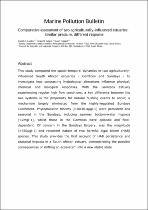JavaScript is disabled for your browser. Some features of this site may not work without it.
- ResearchSpace
- →
- Research Publications/Outputs
- →
- Journal Articles
- →
- View Item
| dc.contributor.author |
Lemley, DA

|
|
| dc.contributor.author |
Adams, JB

|
|
| dc.contributor.author |
Taljaard, Susan

|
|
| dc.date.accessioned | 2017-07-28T09:37:38Z | |
| dc.date.available | 2017-07-28T09:37:38Z | |
| dc.date.issued | 2017-04 | |
| dc.identifier.citation | Lemley, D.A, Adams, J.B. and Taljaard, S. 2017. Comparative assessment of two agriculturally-influenced estuaries: similar pressure, different response. Marine pollution bulletin, 117(1-2), pp136-147 | en_US |
| dc.identifier.issn | 0025-326X | |
| dc.identifier.uri | http://www.sciencedirect.com/science/article/pii/S0025326X17300887 | |
| dc.identifier.uri | http://hdl.handle.net/10204/9415 | |
| dc.description | Copyright: 2017 Elsevier. Due to copyright restrictions, the attached PDF file only contains the abstract of the full text item. For access to the full text item, please consult the publisher's website. The definitive version of the work is published in Marine Pollution Bulletin, 117(1-2), pp136-147 | en_US |
| dc.description.abstract | This study compared the spatio-temporal dynamics in two agriculturally-influenced South African estuaries - Gamtoos and Sundays - to investigate how contrasting hydrological alterations influence physical, chemical and biological responses. With the Gamtoos Estuary experiencing regular high flow conditions, a key difference between the two systems is the propensity for natural flushing events to occur; a mechanism largely eliminated from the highly-regulated Sundays Catchment. Phytoplankton blooms (>20Chl-aµgl-1) were persistent and seasonal in the Sundays, inducing summer bottom-water hypoxia (<2mgl-1), whilst those in the Gamtoos were episodic and flow-dependent. Of concern in the Sundays Estuary, was the magnitude (>550µgl-1) and recurrent nature of two harmful algal bloom (HAB) species. This study provides the first account of HAB persistence and seasonal hypoxia in a South African estuary, demonstrating the possible consequences of shifting an ecosystem into a new stable state | en_US |
| dc.language.iso | en | en_US |
| dc.publisher | Elsevier | en_US |
| dc.relation.ispartofseries | Workflow;18740 | |
| dc.subject | Ecohydrodynamics | en_US |
| dc.subject | Eutrophication | en_US |
| dc.subject | Heterocapsa rotundata | en_US |
| dc.subject | Heterosigma akashiwo | en_US |
| dc.subject | Hypoxia | en_US |
| dc.subject | Phytoplankton | en_US |
| dc.title | Comparative assessment of two agriculturally-influenced estuaries | en_US |
| dc.title.alternative | Similar pressure, different response | en_US |
| dc.type | Article | en_US |
| dc.identifier.apacitation | Lemley, D., Adams, J., & Taljaard, S. (2017). Comparative assessment of two agriculturally-influenced estuaries. http://hdl.handle.net/10204/9415 | en_ZA |
| dc.identifier.chicagocitation | Lemley, DA, JB Adams, and Susan Taljaard "Comparative assessment of two agriculturally-influenced estuaries." (2017) http://hdl.handle.net/10204/9415 | en_ZA |
| dc.identifier.vancouvercitation | Lemley D, Adams J, Taljaard S. Comparative assessment of two agriculturally-influenced estuaries. 2017; http://hdl.handle.net/10204/9415. | en_ZA |
| dc.identifier.ris | TY - Article AU - Lemley, DA AU - Adams, JB AU - Taljaard, Susan AB - This study compared the spatio-temporal dynamics in two agriculturally-influenced South African estuaries - Gamtoos and Sundays - to investigate how contrasting hydrological alterations influence physical, chemical and biological responses. With the Gamtoos Estuary experiencing regular high flow conditions, a key difference between the two systems is the propensity for natural flushing events to occur; a mechanism largely eliminated from the highly-regulated Sundays Catchment. Phytoplankton blooms (>20Chl-aµgl-1) were persistent and seasonal in the Sundays, inducing summer bottom-water hypoxia (<2mgl-1), whilst those in the Gamtoos were episodic and flow-dependent. Of concern in the Sundays Estuary, was the magnitude (>550µgl-1) and recurrent nature of two harmful algal bloom (HAB) species. This study provides the first account of HAB persistence and seasonal hypoxia in a South African estuary, demonstrating the possible consequences of shifting an ecosystem into a new stable state DA - 2017-04 DB - ResearchSpace DP - CSIR KW - Ecohydrodynamics KW - Eutrophication KW - Heterocapsa rotundata KW - Heterosigma akashiwo KW - Hypoxia KW - Phytoplankton LK - https://researchspace.csir.co.za PY - 2017 SM - 0025-326X T1 - Comparative assessment of two agriculturally-influenced estuaries TI - Comparative assessment of two agriculturally-influenced estuaries T2 - Similar pressure, different response UR - http://hdl.handle.net/10204/9415 ER - | en_ZA |






